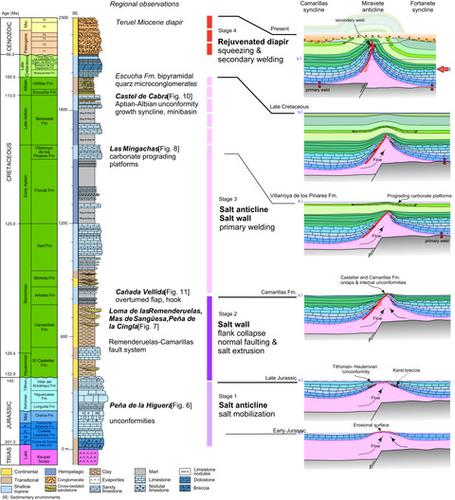当前位置:
X-MOL 学术
›
Basin Res.
›
论文详情
Our official English website, www.x-mol.net, welcomes your feedback! (Note: you will need to create a separate account there.)
Tectono-Sedimentary Evolution of Jurassic-Cretaceous diapiric structures: Miravete anticline, Maestrat Basin, Spain
Basin Research ( IF 3.2 ) Pub Date : 2020-05-11 , DOI: 10.1111/bre.12447 Jaume Vergés 1 , Yohann Poprawski 1, 2 , Ylènia Almar 1 , Peter A. Drzewiecki 3 , Mar Moragas 1, 4 , Telm Bover‐Arnal 5 , Chiara Macchiavelli 1 , Wayne Wright 6 , Grégoire Messager 7 , Jean‐Christophe Embry 8 , David Hunt 9
Basin Research ( IF 3.2 ) Pub Date : 2020-05-11 , DOI: 10.1111/bre.12447 Jaume Vergés 1 , Yohann Poprawski 1, 2 , Ylènia Almar 1 , Peter A. Drzewiecki 3 , Mar Moragas 1, 4 , Telm Bover‐Arnal 5 , Chiara Macchiavelli 1 , Wayne Wright 6 , Grégoire Messager 7 , Jean‐Christophe Embry 8 , David Hunt 9
Affiliation

|
[Abstract Integration of extensive fieldwork, remote sensing mapping and 3D models from high‐quality drone photographs relates tectonics and sedimentation to define the Jurassic–early Albian diapiric evolution of the N–S Miravete anticline, the NW‐SE Castel de Cabra anticline and the NW‐SE Canada Vellida ridge in the Maestrat Basin (Iberian Ranges, Spain). The pre shortening diapiric structures are defined by well‐exposed and unambiguous halokinetic geometries such as hooks and flaps, salt walls and collapse normal faults. These were developed on Triassic salt‐bearing deposits, previously misinterpreted because they were hidden and overprinted by the Alpine shortening. The Miravete anticline grew during the Jurassic and Early Cretaceous and was rejuvenated during Cenozoic shortening. Its evolution is separated into four halokinetic stages, including the latest Alpine compression. Regionally, the well‐exposed Castel de Cabra salt anticline and Canada Vellida salt wall confirm the widespread Jurassic and Early Cretaceous diapiric evolution of the Maestrat Basin. The NE flank of the Canada Vellida salt wall is characterized by hook patterns and by a 500‐m‐long thin Upper Jurassic carbonates defining an upturned flap, inferred as the roof of the salt wall before NE‐directed salt extrusion. A regional E‐W cross section through the Ababuj, Miravete and Canada‐Benatanduz anticlines shows typical geometries of salt‐related rift basins, partly decoupled from basement faults. These structures could form a broader diapiric region still to be investigated. In this section, the Camarillas and Fortanete minibasins displayed well‐developed bowl geometries at the onset of shortening. The most active period of diapiric growth in the Maestrat Basin occurred during the Early Cretaceous, which is also recorded in the Eastern Betics, Asturias and Basque‐Cantabrian basins. This period coincides with the peak of eastward drift of the Iberian microplate, with speeds of 20 mm/year. The transtensional regime is interpreted to have played a role in diapiric development., We illustrate for the first time mixed halokinetic depositional sequences in minibasins limited by salt walls displaying typical flap and hook geometries (salt‐welds and thrust‐welds after Cenozoic shortening), in the Miravete anticline and Maestrat Basin (Iberian Ranges), with Jurassic and Early Cretaceous ages and partly coeval to Iberia‐Europe sinistral motion. ]
中文翻译:

侏罗纪-白垩纪底辟构造的构造-沉积演化:米拉维特背斜,马埃斯特拉特盆地,西班牙
[来自高质量无人机照片的大量实地工作、遥感测绘和 3D 模型的摘要整合涉及构造和沉积,以定义 N-S Miravete 背斜、NW-SE Castel de Cabra 背斜和 NW-SE Castel de Cabra 背斜的侏罗纪-早期阿尔比底辟演化马埃斯特拉特盆地(西班牙伊比利亚山脉)的 NW-SE 加拿大 Vellida 海脊。前缩短底辟构造由暴露良好且明确的盐动力学几何结构定义,例如钩状和襟翼、盐壁和塌陷正断层。这些是在三叠纪含盐沉积物上开发的,以前被误解,因为它们被阿尔卑斯山的起酥油隐藏和覆盖。米拉维特背斜在侏罗纪和早白垩世生长,并在新生代缩短期间恢复活力。它的演化分为四个盐动力学阶段,包括最新的 Alpine 压缩。在区域上,出露良好的 Castel de Cabra 盐背斜和加拿大 Vellida 盐壁证实了 Maestrat 盆地广泛存在的侏罗纪和早白垩世底辟演化。加拿大 Vellida 盐壁的东北侧以钩状图案和 500 米长的薄上侏罗统碳酸盐岩为特征,形成一个上翘的瓣,推断为 NE 定向盐挤压之前的盐壁顶。通过 Ababuj、Miravet 和 Canada-Benatanduz 背斜的区域东西向横截面显示了与盐相关的裂谷盆地的典型几何形状,部分与基底断层分离。这些结构可能形成一个更广泛的底辟区域,仍有待研究。在本节中,Camarillas 和 Fortanete 小型盆地在缩短开始时显示出发育良好的碗状几何形状。马埃斯特拉特盆地底辟发育最活跃的时期发生在早白垩世,在东贝蒂奇、阿斯图里亚斯和巴斯克-坎塔布连盆地也有记录。这一时期恰逢伊比利亚微板块向东漂移的高峰期,速度为 20 毫米/年。张力机制被解释为在底辟发育中发挥了作用。我们首次说明了受盐壁限制的小型盆地中的混合盐动力沉积序列,显示出典型的襟翼和钩状几何形状(新生代缩短后的盐焊缝和逆冲焊缝),在米拉维特背斜和马埃斯特拉特盆地(伊比利亚山脉),侏罗纪和早白垩世时代,部分与伊比利亚-欧洲左旋运动同时期。] 这也记录在东贝蒂奇、阿斯图里亚斯和巴斯克-坎塔布连盆地。这一时期恰逢伊比利亚微板块向东漂移的高峰期,速度为 20 毫米/年。张力机制被解释为在底辟发育中发挥了作用。我们首次说明了受盐壁限制的小型盆地中的混合盐动力沉积序列,显示出典型的襟翼和钩状几何形状(新生代缩短后的盐焊缝和逆冲焊缝),在米拉维特背斜和马埃斯特拉特盆地(伊比利亚山脉),侏罗纪和早白垩世时代,部分与伊比利亚-欧洲左旋运动同时期。] 这也记录在东贝蒂奇、阿斯图里亚斯和巴斯克-坎塔布连盆地。这一时期恰逢伊比利亚微板块向东漂移的高峰期,速度为 20 毫米/年。张力机制被解释为在底辟发育中发挥了作用。我们首次说明了受盐壁限制的小型盆地中的混合盐动力沉积序列,显示出典型的襟翼和钩状几何形状(新生代缩短后的盐焊缝和逆冲焊缝),在米拉维特背斜和马埃斯特拉特盆地(伊比利亚山脉),侏罗纪和早白垩世时代,部分与伊比利亚-欧洲左旋运动同时期。] 张力机制被解释为在底辟发育中发挥了作用。我们首次说明了受盐壁限制的小型盆地中的混合盐动力沉积序列,显示出典型的襟翼和钩状几何形状(新生代缩短后的盐焊缝和逆冲焊缝),在米拉维特背斜和马埃斯特拉特盆地(伊比利亚山脉),侏罗纪和早白垩世时代,部分与伊比利亚-欧洲左旋运动同时期。] 张力机制被解释为在底辟发育中发挥了作用。我们首次说明了受盐壁限制的小型盆地中的混合盐动力沉积序列,显示出典型的襟翼和钩状几何形状(新生代缩短后的盐焊缝和逆冲焊缝),在米拉维特背斜和马埃斯特拉特盆地(伊比利亚山脉),侏罗纪和早白垩世时代,部分与伊比利亚-欧洲左旋运动同时期。] 侏罗纪和早白垩世时代,部分与伊比利亚-欧洲左旋运动同时期。] 侏罗纪和早白垩世时代,部分与伊比利亚-欧洲左旋运动同时期。]
更新日期:2020-05-11
中文翻译:

侏罗纪-白垩纪底辟构造的构造-沉积演化:米拉维特背斜,马埃斯特拉特盆地,西班牙
[来自高质量无人机照片的大量实地工作、遥感测绘和 3D 模型的摘要整合涉及构造和沉积,以定义 N-S Miravete 背斜、NW-SE Castel de Cabra 背斜和 NW-SE Castel de Cabra 背斜的侏罗纪-早期阿尔比底辟演化马埃斯特拉特盆地(西班牙伊比利亚山脉)的 NW-SE 加拿大 Vellida 海脊。前缩短底辟构造由暴露良好且明确的盐动力学几何结构定义,例如钩状和襟翼、盐壁和塌陷正断层。这些是在三叠纪含盐沉积物上开发的,以前被误解,因为它们被阿尔卑斯山的起酥油隐藏和覆盖。米拉维特背斜在侏罗纪和早白垩世生长,并在新生代缩短期间恢复活力。它的演化分为四个盐动力学阶段,包括最新的 Alpine 压缩。在区域上,出露良好的 Castel de Cabra 盐背斜和加拿大 Vellida 盐壁证实了 Maestrat 盆地广泛存在的侏罗纪和早白垩世底辟演化。加拿大 Vellida 盐壁的东北侧以钩状图案和 500 米长的薄上侏罗统碳酸盐岩为特征,形成一个上翘的瓣,推断为 NE 定向盐挤压之前的盐壁顶。通过 Ababuj、Miravet 和 Canada-Benatanduz 背斜的区域东西向横截面显示了与盐相关的裂谷盆地的典型几何形状,部分与基底断层分离。这些结构可能形成一个更广泛的底辟区域,仍有待研究。在本节中,Camarillas 和 Fortanete 小型盆地在缩短开始时显示出发育良好的碗状几何形状。马埃斯特拉特盆地底辟发育最活跃的时期发生在早白垩世,在东贝蒂奇、阿斯图里亚斯和巴斯克-坎塔布连盆地也有记录。这一时期恰逢伊比利亚微板块向东漂移的高峰期,速度为 20 毫米/年。张力机制被解释为在底辟发育中发挥了作用。我们首次说明了受盐壁限制的小型盆地中的混合盐动力沉积序列,显示出典型的襟翼和钩状几何形状(新生代缩短后的盐焊缝和逆冲焊缝),在米拉维特背斜和马埃斯特拉特盆地(伊比利亚山脉),侏罗纪和早白垩世时代,部分与伊比利亚-欧洲左旋运动同时期。] 这也记录在东贝蒂奇、阿斯图里亚斯和巴斯克-坎塔布连盆地。这一时期恰逢伊比利亚微板块向东漂移的高峰期,速度为 20 毫米/年。张力机制被解释为在底辟发育中发挥了作用。我们首次说明了受盐壁限制的小型盆地中的混合盐动力沉积序列,显示出典型的襟翼和钩状几何形状(新生代缩短后的盐焊缝和逆冲焊缝),在米拉维特背斜和马埃斯特拉特盆地(伊比利亚山脉),侏罗纪和早白垩世时代,部分与伊比利亚-欧洲左旋运动同时期。] 这也记录在东贝蒂奇、阿斯图里亚斯和巴斯克-坎塔布连盆地。这一时期恰逢伊比利亚微板块向东漂移的高峰期,速度为 20 毫米/年。张力机制被解释为在底辟发育中发挥了作用。我们首次说明了受盐壁限制的小型盆地中的混合盐动力沉积序列,显示出典型的襟翼和钩状几何形状(新生代缩短后的盐焊缝和逆冲焊缝),在米拉维特背斜和马埃斯特拉特盆地(伊比利亚山脉),侏罗纪和早白垩世时代,部分与伊比利亚-欧洲左旋运动同时期。] 张力机制被解释为在底辟发育中发挥了作用。我们首次说明了受盐壁限制的小型盆地中的混合盐动力沉积序列,显示出典型的襟翼和钩状几何形状(新生代缩短后的盐焊缝和逆冲焊缝),在米拉维特背斜和马埃斯特拉特盆地(伊比利亚山脉),侏罗纪和早白垩世时代,部分与伊比利亚-欧洲左旋运动同时期。] 张力机制被解释为在底辟发育中发挥了作用。我们首次说明了受盐壁限制的小型盆地中的混合盐动力沉积序列,显示出典型的襟翼和钩状几何形状(新生代缩短后的盐焊缝和逆冲焊缝),在米拉维特背斜和马埃斯特拉特盆地(伊比利亚山脉),侏罗纪和早白垩世时代,部分与伊比利亚-欧洲左旋运动同时期。] 侏罗纪和早白垩世时代,部分与伊比利亚-欧洲左旋运动同时期。] 侏罗纪和早白垩世时代,部分与伊比利亚-欧洲左旋运动同时期。]



























 京公网安备 11010802027423号
京公网安备 11010802027423号